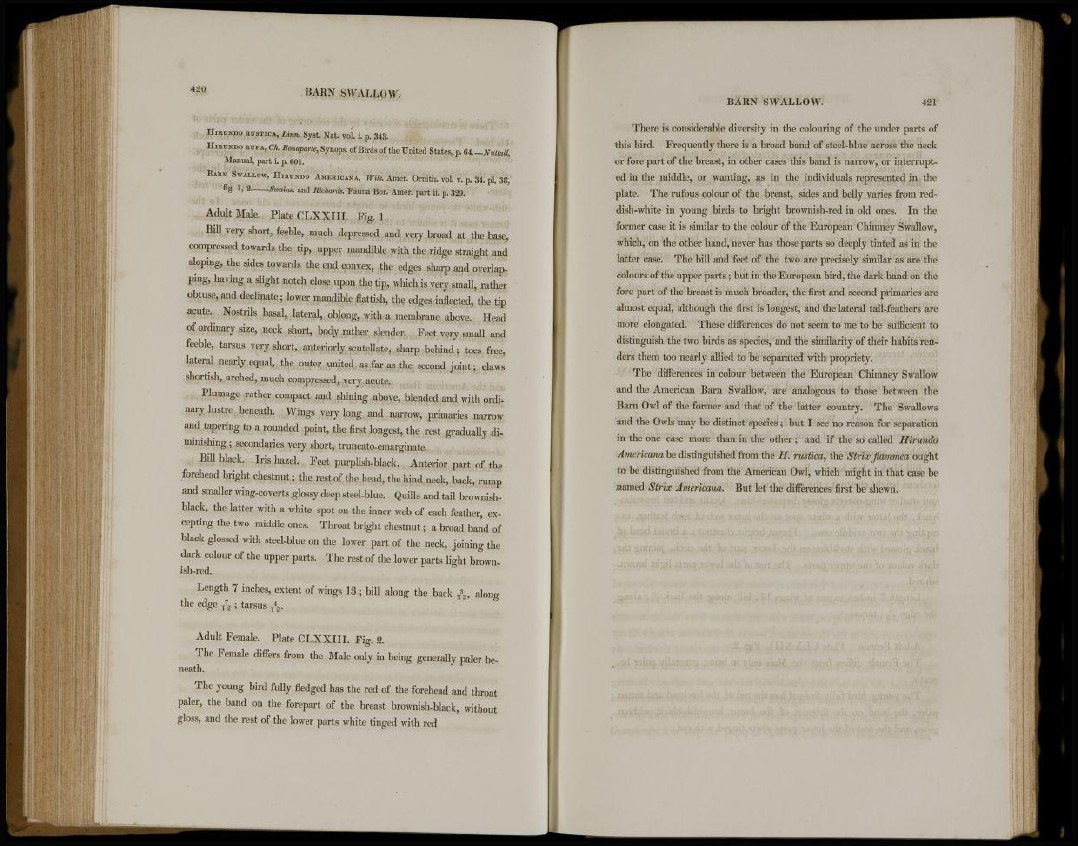
420 BARN SWALLOW.
HIRUNDO RUSTICA, Linn. Syst. Nat. vol. i. p. 343.
HIRUNDO RUFA, Ch. Bonaparte, Synops. of Birds of the United States, p. 64—Nultatt,
Manual, part i. p. 601.
BARN SWALLOW, HIRUNDO AMERICANA, Wits. Amer. Ornith. vol. v. p. 34. pL 38,
fig, 1, 2. Swains, and Richards. Fauna Bor. Amer. part ii. p. 329.
Adult Male. Plate CLXXIII. Fig. 1.
Bill very short, feeble, much depressed and very broad at the base,
compressed towards the tip, upper mandible with the ridge straight and
sloping, the sides towards the end convex, the edges sharp and overlapping,
having a slight notch close upon the tip, which is very small, rather
obtuse, and declinate; lower mandible flattish, the edges inflected, the tip
acute. Nostrils basal, lateral, oblong, with a membrane above. Head
of ordinary size, neck short, body rather slender. Feet very small and
feeble, tarsus very short, anteriorly scutellate, sharp behind; toes free,
lateral nearly equal, the outer united as far as the second joint; claws
shortish, arched, much compressed, very acute.
Plumage rather compact and shining above, blended and with ordinary
lustre beneath. Wings very long and narrow, primaries narrow
and tapering to a rounded point, the first longest, the rest gradually diminishing
; secondaries very short, truncato-emarginate.
Bill black. Iris hazel. Feet purplish-black. Anterior part of the
forehead bright chestnut; the rest of the head, the hind neck, back, rump
and smaller wing-coverts glossy deep steel-blue. Quills and tail brownishblack,
the latter with a white spot on the inner web of each feather, excepting
the two middle ones. Throat bright chestnut; a broad band of
black glossed with steel-blue on the lower part of the neck, joining the
dark colour of the upper parts. The rest of the lower parts light brownish
red.
Length 7 inches, extent of wings 13 ; bill along the back ft, along
the edge ft ; tarsus ft.
Adult Female. Plate CLXXIII. Fig. 2.
The Female diners from the Male only in being generally paler beneath.
The young bird fully fledged has the red of the forehead and throat
paler, the band on the forepart of the breast brownish-black, without
gloss, and the rest of the lower parts white tinged with red
BARN SWALLOW. 421
There is considerable diversity in the colouring of the under parts of
this bird. Frequently there is a broad band of steel-blue across the neck
or fore part of the breast, in other cases this band is narrow, or interrupted
in the middle, or wanting, as in the individuals represented in the
plate. The rufous colour of the breast, sides and belly varies from reddish
white in young birds to bright brownish-red in old ones. In the
former case it is similar to the colour of the European Chimney Swallow,
which, on the other hand, never has those parts so deeply tinted as in the
latter case. The bill and feet of the two are precisely similar as are the
colours of the upper parts; but in the European bird, the dark band on the
fore part of the breast is much broader, the first and second primaries are
almost equal, although the first is longest, and the lateral tail-feathers are
more elongated. These differences do not seem to me to be sufficient to
distinguish the two birds as species, and the similarity of their habits renders
them too nearly allied to be separated with propriety.
The differences in colour between the European Chimney Swallow
and the American Barn Swallow, are analogous to those between the
Barn Owl of the former and that of the latter country. The Swallows
and the Owls may be distinct species; but I see no reason for separation
in the one case more than in the other; and if the so called Hirundo
Americana be distinguished from the H. rustica, the Stria: jiammca ought
to be distinguished from the American Owl, which might in that case be
named Stria: Americana. But let the differences first be shewn.